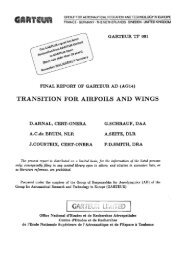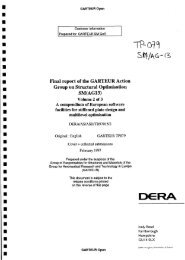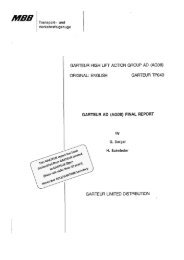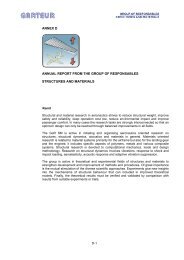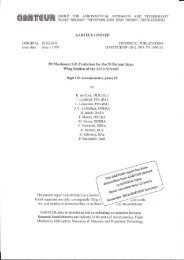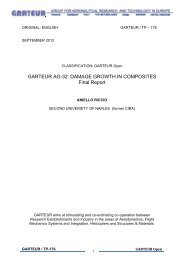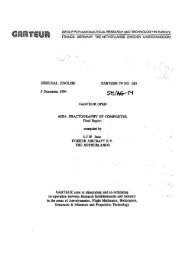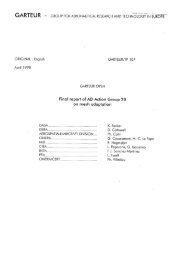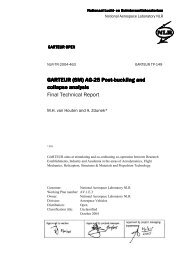Cadmium Substitution - garteur
Cadmium Substitution - garteur
Cadmium Substitution - garteur
Create successful ePaper yourself
Turn your PDF publications into a flip-book with our unique Google optimized e-Paper software.
GARTEUR LIMITED<br />
C.3.2.3<br />
Electrochemical measurements<br />
Results of the OCP measurements are presented in table C11. In general the zinc based<br />
coatings (ED zinc-nickel, ED zinc-cobalt-iron and Delta-tone) exhibit much lower<br />
potentials than the aluminium coatings. On this basis it would be expected that the zinc<br />
rich coatings would provide a greater level of sacrificial protection and this is supported<br />
by the accelerated corrosion tests and outdoor exposure trials on scribed panels.<br />
The average galvanic corrosion currents measured using the Scratch Model specimens<br />
are summarised in table C12. In broad agreement with the findings of the OCP studies<br />
the as deposited zinc based coatings show higher levels of galvanic corrosion current<br />
than the pure aluminium coatings and SermeTel 984. Measurements made on the UBMS<br />
aluminium - magnesium coating confirm that this is a more sacrificial coating than pure<br />
aluminium.<br />
Data obtained from the cathodic protection measurement technique were used to<br />
calculate the protection distance for each of the coatings studied. This represents the<br />
distance over which a coating can provide sacrificial protection to the steel strip. The<br />
results are presented in table C13. This shows that the two pure aluminium coatings are<br />
relatively poor sacrificial coatings whilst the zinc based coatings provide protection over<br />
much greater distances than cadmium plating. The aluminium - magnesium coating<br />
shows a significant improvement over pure aluminium and is more effective than<br />
cadmium plating.<br />
C.4 Conclusions<br />
1. Overall the aluminium based coatings were found to have superior barrier properties<br />
to the zinc rich deposits studied in this investigation.<br />
2. Electrochemical and accelerated corrosion tests have demonstrated that the zinc rich<br />
deposits are more effective in preventing the onset of rusting at scratches or defects<br />
in the coating than pure aluminium or aluminium alloy coatings.<br />
C.5 References<br />
[C1]<br />
[C2]<br />
[C3]<br />
Standard method of salt spray (fog) testing, ASTM B117-73 published by the<br />
American Society for Testing and Materials, Philadelphia, Pa. 19103 (1973)<br />
Lifka B.W. and Sprowls D. "An improved exfoliation test for aluminium alloys",<br />
Corrosion 22 p7 (1966)<br />
Modified salt spray (fog) testing, ASTM G85-84 published by the American<br />
Society for Testing and Materials, Philadelphia, Pa. 19103 (1984)<br />
[C4] Standard method for Testing Coated Metal Specimens at 100% Relative<br />
Humidity, ASTM D2247-68 published by the American Society for Testing and<br />
Materials, Philadelphia, Pa. 19103 (1980)<br />
[C5]<br />
[C6]<br />
Smith C.J.E., Baldwin K.R., Hewins M.A.H. and Gibson M.C., “A Study into the<br />
Corrosion Inhibition of an Aluminium Alloy by Cerium Salts” published in<br />
“Progress in the Understanding and Prevention of Corrosion” pp1652 - 1663<br />
(1993)<br />
Jansen E.F.M. and 'tHart W.G.J., Corrosion properties of cadmium, ZnNi, ZnCoFe<br />
and SERMETEL coatings - Garteur <strong>Cadmium</strong> <strong>Substitution</strong> programme NLR<br />
Progress Report 1- NLR CR 95607 L (1995)<br />
GARTEUR SM/AG17 TP128 Page 61




